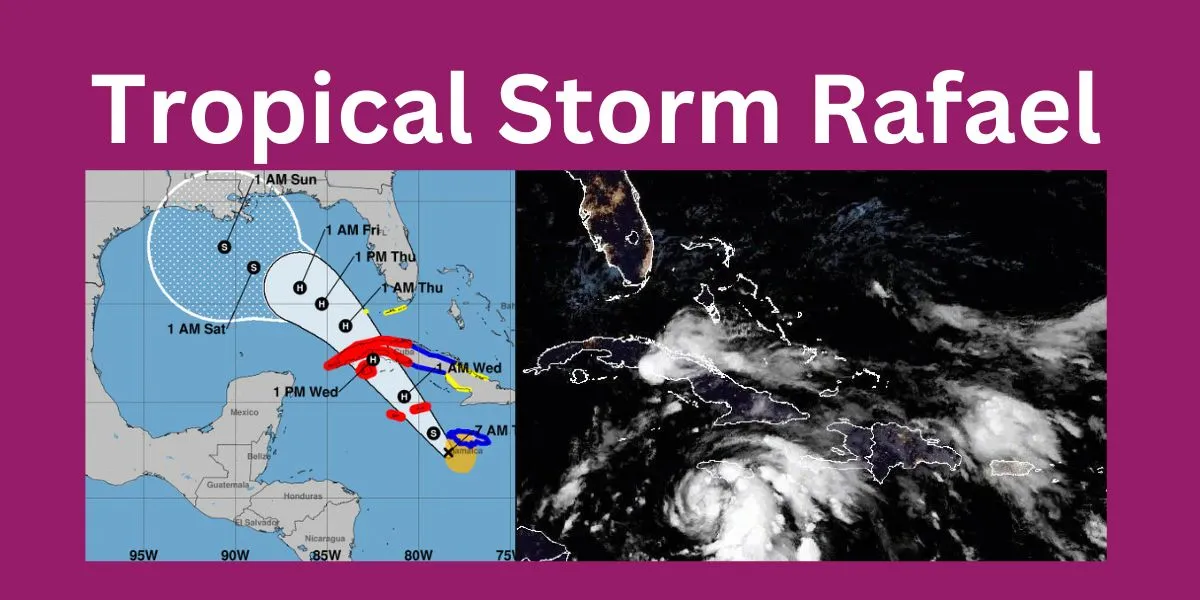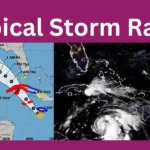When tropical storms form, they capture our attention with their powerful winds, heavy rains, and the potential for destruction. Tropical Storm Rafael is no different. Whether you’re in the storm’s path or just curious, it’s essential to understand what makes these storms tick, how they affect us, and how we can stay safe.
What is Tropical Storm Rafael?
The Basics of Tropical Storm Rafael
Tropical Storm Rafael is one of the many storms that form during the Atlantic hurricane season. It follows the same formation process as other tropical storms but has its unique characteristics. Named after the Spanish word for “God has healed,” Rafael is a reminder of the unpredictable power of nature.
How Tropical Storms Form
Tropical storms like Rafael form over warm ocean waters, usually in the tropics. When the water temperature reaches at least 80°F, it fuels the storm, causing it to develop into a system with strong winds and heavy rain. As warm, moist air rises, it cools and condenses, forming clouds and thunderstorms. If the system grows, it can become a tropical storm.
Characteristics of Tropical Storm Rafael
- Wind Speeds: Tropical Storm Rafael has wind speeds between 39-73 mph.
- Rainfall: Expect heavy rainfall, often leading to flooding.
- Path: The storm’s path can be unpredictable, but meteorologists use advanced technology to track its movements.
The Impact of Tropical Storm Rafael
A Closer Look at the Damage
Tropical storms can cause significant damage. Rafael is no exception. Let’s break down the potential impacts.
Wind Damage
Strong winds are a hallmark of tropical storms. Rafael’s winds can knock down trees, power lines, and even weak structures. If you’re in the storm’s path, securing loose items around your home is crucial.
Flooding and Rainfall
Heavy rain from Rafael can lead to flooding, especially in low-lying areas. Flash floods are particularly dangerous, as they can occur quickly and with little warning. It’s essential to stay informed about local weather updates and avoid driving through flooded areas.
Storm Surges
Although more common in hurricanes, tropical storms like Rafael can still cause storm surges. This is when the storm pushes ocean water onto the land, leading to coastal flooding. Coastal communities should be particularly vigilant.
Preparing for Tropical Storm Rafael
Don’t Get Caught Off Guard
Preparation is key when facing a tropical storm. Here’s how you can stay safe and minimize damage.
Emergency Kits and Plans
Every household should have an emergency kit ready. This kit should include:
- Non-perishable food and water
- Flashlights and extra batteries
- First aid supplies
- Important documents in a waterproof container
Securing Your Home
To protect your home:
- Board up windows or install hurricane shutters.
- Bring in outdoor furniture and other loose items.
- Check your roof and gutters to ensure they are secure and clear of debris.
Staying Informed
Stay tuned to local news and weather updates. Use apps, listen to the radio, or watch TV to get the latest information on Tropical Storm Rafael’s path and intensity.
What to Do During the Storm
Riding Out Rafael
When the storm hits, it’s vital to stay safe and know what to do.
Staying Indoors
Stay inside and away from windows. If you live in a flood-prone area, move to higher ground or the upper floors of your home.
Power Outages
Power outages are common during tropical storms. Have flashlights and a battery-powered radio on hand. Avoid using candles, as they can be a fire hazard.
Communication
Keep your phone charged and have a backup power source, like a portable charger. Stay in touch with family and friends to let them know you’re safe.
The Aftermath of Tropical Storm Rafael
Picking Up the Pieces
After the storm passes, the recovery process begins. Here’s what you need to know.
Assessing Damage
Once it’s safe, inspect your property for damage. Take photos for insurance purposes and document everything. This will make the claims process smoother.
Helping Others
Check on your neighbors, especially the elderly or those with young children. Offer assistance if needed, and share resources like food and water if you can.
Staying Safe Post-Storm
Even after the storm has passed, dangers remain. Watch out for downed power lines, avoid floodwaters, and listen to local authorities for instructions.
Learning from Tropical Storm Rafael
Being Better Prepared for the Future
Every storm teaches us something. Rafael is a reminder of the importance of preparation and community support.
Improving Preparedness
Use the lessons learned from Rafael to improve your emergency plans. Make note of what worked and what didn’t, and make adjustments accordingly.
Community Resilience
Communities that come together recover faster. Participate in local recovery efforts and support organizations that provide aid to those affected.
Conclusion
Tropical Storm Rafael is a powerful reminder of nature’s unpredictability. By understanding the storm, preparing effectively, and staying safe during and after its impact, we can mitigate its effects. Remember, staying informed and prepared is the best defense against any tropical storm.
FAQs
1. What is the difference between a tropical storm and a hurricane?
Tropical storms have wind speeds of 39-73 mph, while hurricanes have winds of 74 mph or higher. Hurricanes are also more intense and can cause greater damage.
2. How can I track Tropical Storm Rafael?
You can track Rafael using weather apps, local news updates, or the National Hurricane Center’s website for real-time information.
3. What should I do if my home floods during the storm?
Move to higher ground immediately. Avoid walking or driving through floodwaters, and contact emergency services if necessary.
4. How long do tropical storms typically last?
Tropical storms can last from a few hours to several days, depending on their strength and path. It’s essential to stay updated throughout the storm.
5. Can Tropical Storm Rafael turn into a hurricane?
Yes, if the storm gains strength and its wind speeds exceed 74 mph, it can be upgraded to a hurricane. Keep an eye on updates from meteorologists.










